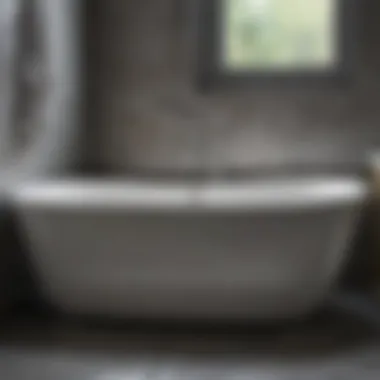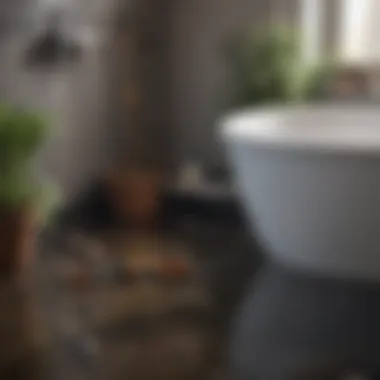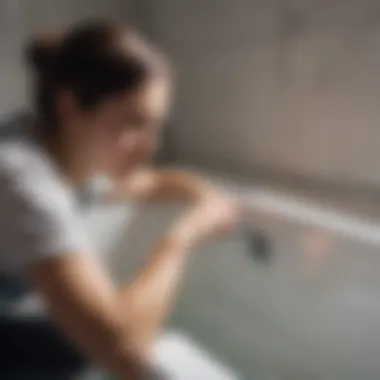Resolving Poor Tub Drainage: Causes & Solutions


Intro
In recent years, the quality of home plumbing systems has taken center stage among homeowners. One critical aspect of these systems is the bathtub drainage. When drainage becomes slow, it signifies potential underlying problems that could escalate if left unattended. Understanding the reasons behind poor tub drainage can empower homeowners to take corrective actions before minor issues worsen.
Clogs and blockages in tub drains can lead to frustration, unsanitary conditions, and costly repairs. Observing early signs like water pooling or slow drainage can help in addressing these issues promptly. This article aims to dissect the common causes of inadequate tub drainage and provide a thorough guide for troubleshooting and resolving these matters.
The overall goal is to build a clear understanding of how plumbing mechanics operate within the home. By detailing not just the causes but also practical solutions, this text serves as a valuable resource for anyone looking to maintain their bathroom's functionality.
As we delve deeper into the subject, expect to uncover the complexity of plumbing, the signs indicating trouble, and effective methods for repair.
Prolusion to Tub Drainage Problems
Understanding tub drainage issues is crucial for maintaining a functional and pleasant bathroom environment. Proper drainage ensures that water flows efficiently from the bathtub, preventing overflow or unpleasant odors from accumulating. In this article, we will delve deep into the mechanics of tub drainage, highlight common problems, and propose effective solutions. Homeowners must recognize that addressing drainage issues is not just about immediate fixes. It is about cultivating a proactive approach to plumbing maintenance.
Understanding Tub Drain Mechanisms
Every tub equipped with a drainage system operates under specific principles. Typically, water exits through the drain pipe, moving towards a sewer system or a septic tank. The components of this system include the drain line, trap, and vent. The drain line channels water away, while the trap prevents sewer gases from entering the home. The vent provides airflow to the pipes, ensuring smooth water movement. Problems may arise if any of these parts become compromised. A solid understanding of these elements empowers homeowners to troubleshoot issues more effectively.
Importance of Proper Drainage
Good drainage is essential for several reasons. First and foremost, it helps maintain hygienic conditions in the bathroom. When water does not drain properly, it creates a breeding ground for mold and bacteria. Additionally, accumulated water can lead to structural damage and increased repair costs over time. Homeowners should be aware of indications of poor drainage, such as slow water flow or unusual sounds during draining.
Taking preventive measures is also vital. Investing time in regular maintenance and inspections can prevent costly repairs and enhance overall home comfort. The understanding of drainage systems, alongside recognition of their importance, sets the foundation for effective bathroom care.
Common Causes of Drainage Issues
Understanding the common causes of drainage issues is essential for homeowners. When a bathtub experiences drainage problems, it can disrupt daily routines and lead to potential water damage. Identifying the specific causes allows for more effective solutions. This section explores significant elements that contribute to poor drainage, providing insight that empowers homeowners to take timely and informed actions.
Clogs from Hair and Soap Scum
Hair and soap scum are among the leading culprits behind bathtub clogs. Over time, hair strands accumulate in the drain, intertwining with soap residue and other debris. This combination creates a dense mass that obstructs proper water flow.
Moreover, the gradual build-up may not be apparent at first. Homeowners may notice water draining slowly as an initial indication of a problem. Regular maintenance can significantly reduce the risk of these clogs. Simple practices like using drain screens can trap hair and prevent it from entering the pipes. Furthermore, frequent cleaning of the drain area helps minimize soap scum accumulation, ensuring smoother drainage.
Mineral Buildup from Hard Water
Hard water can lead to mineral deposits, particularly calcium and magnesium, which adhere to pipes and fixtures over time. This mineral buildup narrows the diameter of pipes, making it difficult for water to drain effectively. Homeowners in areas with hard water should be vigilant about these issues.
Using a water softener can help reduce mineral content, thus preventing buildup. Additionally, periodic descaling of faucets and showerheads with vinegar can remove existing deposits. Being proactive in managing hard water effects can maintain the integrity of plumbing systems.
Misaligned or Damaged Pipes
Misalignment or damage to pipes can severely hinder drainage efficiency. When pipes are not properly aligned, water may not flow as intended, leading to backups or slow drainage. In older homes, wear and tear can lead to cracks and leaks. This issue requires careful evaluation to determine the extent of the damage.
Homeowners should consider scheduling regular inspections by a professional plumber. These assessments can catch potential problems early, allowing for timely repairs before major issues arise. Repairing or replacing damaged pipes is crucial for restoring proper drainage.
Sewer Line Issues
Sewer line problems pose a significant threat to bathtub drainage. Issues may arise from blockages or tree roots intruding into the pipes, leading to severe backups. If there is an issue with the sewer line, multiple drains in the home may exhibit problems simultaneously.
Recognizing signs like gurgling noises, foul odors, or slow draining across multiple fixtures can indicate a sewer line issue. Homeowners facing these symptoms should seek professional assistance quickly, as neglecting sewer problems can lead to extensive damage and costly repairs.
Overflow Problems
Overflow issues can also contribute to drainage complications. An improperly functioning overflow drain can lead water to pool around the tub. Occasionally, it may also allow water to leak into surrounding areas, causing further damage.
Regular inspection of the overflow drain can help ensure that it is functioning correctly. Homeowners should also be aware of their bathtub's design to know if the overflow drain is working as intended. Addressing overflow issues early can prevent more significant problems down the line.
Understanding these common causes of drainage issues provides homeowners with the knowledge to maintain their bathtubs effectively. By being proactive, many plumbing concerns can be avoided.


Identifying Symptoms of Drainage Problems
Identifying symptoms of drainage problems is an essential part of maintaining a functional tub. Symptoms can often signal deeper issues that might escalate if not addressed promptly. Recognizing these signs early can save homeowners time and money, while ensuring effective management of home plumbing systems. The good news is that many symptoms are fairly easy to spot, requiring only a careful observation of tub and drainage conditions. In this section, we will discuss key symptoms and their implications to help you respond appropriately.
Slow Draining Water
One of the first indicators of drainage issues is slow-draining water. When you notice that the tub does not empty at its usual speed, it is likely a sign of a blockage forming within the pipes. This could be due to hair, soap scum, or even mineral buildup. It is important to pay attention to how quickly the tub drains after use; any noticeable delay could mean that a deeper investigation is needed.
Ignoring this symptom can lead to complete blockages, resulting in a standing water situation which poses risks of mold or damage to the tub. It is advisable to regularly check the drain’s performance after baths or showers to catch any signs of slowing early.
Unpleasant Odors
Foul smells emanating from the drain can be another key symptom, often indicating stagnant water or organic material decomposing within the drainage system. Odors may suggest that the trap is dry or that there are significant clogs developing that require attention. Sometimes, what appears as a simple odor issue can be a precursor to more serious plumbing problems.
Homeowners should not overlook unpleasant smells. If they persist even after cleaning efforts, it may be time to inspect the pipes and connections for any more serious drainage issues. Keeping the area around the tub clean can aid in minimizing these odors, but dealing with the source is critical.
Gurgling Noises from The Drain
Gurgling or bubbling sounds from the drain can be quite alarming. These noises often signify that air is trapped in the plumbing system, usually due to a clog somewhere in the line. As water tries to pass through a blockage, it can cause air to escape, leading to these unusual sounds. Not all drains make noise, but if your usually quiet drain starts gurgling, it could be a cause for concern.
Homeowners should take these sounds seriously and not dismiss them as trivial. Often, gurgling indicates that immediate action is needed to prevent more significant issues like backups or complete obstructions from forming in the drainage system.
Water Pooling Around the Tub
If you start to see water pooling around the base of the tub, this is a clear sign of a drainage issue. Pooling water could imply that the water is not draining properly due to clogs or other plumbing failures. This situation not only presents an inconvenience but can also lead to water damage around the tub area, impacting flooring and surrounding structures.
To address pooling, it is vital to examine the drainage system for blockages or leaks. Immediate attention can prevent potential damage and preserve the tub's structural integrity. Regular checks on drainage performance are fundamental in catching such symptoms before they worsen.
Better awareness and timely action in response to symptoms can lead to more effective maintenance of tub drainage systems.
Preliminary Troubleshooting Techniques
In the investigation of poor tub drainage, preliminary troubleshooting techniques serve as the first line of defense. These methods empower homeowners to identify and confront minor issues before they escalate into significant problems. Understanding how to perform basic assessments can save time and money, as it can prevent the need for costly repairs or professional services. Thus, mastering these techniques is essential for maintaining effective drainage in bathtubs.
Visual Inspection of the Drain
A visual inspection of the drain is a crucial first step in diagnosing drainage problems. This method involves checking for visible signs of obstruction or damage. Homeowners should look for hair, soap scum, and other debris that may block the flow of water. Additionally, examining the condition of the drain cover can reveal whether it's cracked or loose, which can also contribute to drainage issues.
An effective thorough inspection can help pinpoint the exact location of a problem, allowing for more targeted repairs.
To perform a visual inspection:
- Remove the drain cover carefully.
- Shine a flashlight into the drain to illuminate the internal structures.
- Look for any blockages or buildup that seem apparent.
- Notice if any parts appear damaged or misaligned.
Taking immediate action based on this inspection can greatly improve your tub’s drainage capability.
Handling Basic Clogs with Plungers
Plungers are commonly recognized as useful tools for handling basic clogs in drainage systems. A strong suction generated by the plunger can dislodge objects causing the blockage. This method is particularly effective for more superficial clogs caused by hair or soap scum. Homeowners should consider the type of plunger they use. A cup plunger is effective for sink and tub drains, while a flange plunger is more suited for toilets.
To use a plunger:
- Fill the tub with enough water to cover the bottom of the plunger.
- Position the plunger over the drain, ensuring a tight seal.
- Push down firmly and pull up for about 15-20 seconds.
- If the water begins to drain, the clog has likely been removed.
Repeated attempts may be necessary for stubborn clogs. If water still does not drain correctly, further intervention may be needed.
Using Drain Cleaning Solutions
Drain cleaning solutions can provide an effective route for managing clogs but should be approached with caution. Chemical cleaners can dissolve blockages, but their caustic nature may pose risks to both plumbing systems and personal safety. Eco-friendly alternatives like baking soda and vinegar can achieve similar results in a safer manner.


When utilizing commercial drain cleaning products, it is essential to follow the instructions carefully. Such products might require:
- A designated waiting period to allow chemicals to work.
- Sufficient flushing with water post-application to clear out residues.
Homeowners should always opt for products that specify compatibility with their plumbing systems. This approach prevents damage to pipes and fixtures, ensuring long-term effectiveness of the drainage system.
In-Depth Evaluation of Drainage Systems
A thorough evaluation of the drainage system in your bathtub is essential to understand the root causes of poor drainage. This section addresses the need for a systematic approach to inspecting your plumbing setup. Focusing on various components of the drainage system allows homeowners to identify specific issues contributing to inefficiency. By assessing the integrity of pipes, examining the effects of hard water, and inspecting overflow drains, you gain valuable insight into potential repairs that can restore optimal functionality.
With a clear understanding of your drainage system, you will be in a better position to address existing problems or prevent future complications, ultimately preserving the lifespan of your bathtub and improving your overall bathing experience.
Assessing Pipe Integrity and Alignment
For a well-functioning drainage system, the condition of pipes is paramount. It is important to check for any signs of damage such as cracks, leaks, or corrosion. Misalignment can also lead to slow draining issues, as water may not flow as designed.
To assess pipe integrity:
- Visual Inspection: Look for visible cracks or deformations in exposed pipes.
- Leak Tests: Place absorbent material under pipes to check for leaks.
- Sound Tests: Tap on the pipes with a tool to determine if they produce a hollow sound, indicating potential blockages.
If you find significant issues, it is best to consult a professional plumber. They can offer precise evaluations and recommend repairs to resolve alignment problems.
Checking for Hard Water Effects
Hard water can be a silent enemy to plumbing systems. It contains high levels of minerals such as calcium and magnesium which can accumulate over time, leading to significant drainage problems.
To check for hard water effects:
- Observe Build-Up: Look for white, chalky substances on faucets or around the drain. These are signs of limescale.
- Water Testing: Conduct a hard water test using store-bought kits which measure mineral concentration.
If hard water is indeed an issue, consider installing a water softener or regularly using descaling agents. This will help to mitigate the impacts of mineral build-up more effectively.
Inspecting the Overflow Drain
The overflow drain serves a crucial purpose: it prevents the tub from overflowing by redirecting excess water. Problems with this drain can lead to serious issues, including water damage and mold growth.
In your inspection of the overflow drain:
- Check for Blockages: Use your hand or a thin tool to see if the drain is obstructed.
- Test Functionality: Fill the tub to the overflow drain level and observe if water drains away without issue.
Ignoring this component can exacerbate drainage problems, leading to expensive repairs down the line. Regular checks will go a long way toward maintaining your bathtub's efficiency.
"Preventative measures are key to ensuring a long-lasting drainage system. Regular inspections can help catch problems before they escalate."
Effective Repair Methods for Drainage Issues
Repairing poor tub drainage is essential for maintaining the integrity of your plumbing system. A well-functioning drain prevents water from pooling and keeps your bathroom sanitary. Homeowners should know effective methods to resolve these issues, as they can save time and money in the long run.
Clearing Hair and Debris from Drains
Hair and debris are common culprits of bathtub drainage issues. Clearing them can often be the first step to restore functionality. Homeowners may use various methods to tackle this problem.
- Manual Removal: Sometimes, using a pair of gloves and a flashlight can help identify debris near the drain. This easy, direct approach can swiftly clear a blockage.
- Plungers: A plunger can be effective for dislodging larger clogs. Ensure to create a good seal around the drain to maximize pressure.
When tackling hair clogs, frequency of cleaning also matters. Regular maintenance can help prevent severe blockages from forming in the first place.
Installing Drain Screens
Drain screens serve as a preventive measure. They catch hair and larger debris before it enters the drainage system. Here are a few advantages of installing drain screens:


- Cost-effective: They are inexpensive and easy to install.
- Reducing Clogs: Screens can significantly lower the chance of hair build-up and other debris accumulating in your pipes.
- Easy Cleaning: Most screens are removable for easy cleaning, promoting ongoing maintenance without much effort.
Incorporating a drain screen into your bathtub can mitigate future drainage problems.
Cleaning with Baking Soda and Vinegar
Baking soda and vinegar is an effective natural cleaning method. This combination helps dissolve minor clogs while freshening up the drain. Here’s how to use them:
- Pour half a cup of baking soda down the drain.
- Follow it with half a cup of vinegar.
- Cover the drain for 15-30 minutes to allow the mixture to work on the blockage.
- Rinse with hot water to clear away any remaining debris.
This method offers a simple solution that is both eco-friendly and effective against buildup.
Professional Plumbing Interventions
While many drainage issues can be resolved by homeowners, some problems may require professional assistance. Situations like repeated clogging, foul odors, or drainage backups often indicate deeper issues. Here are some reasons why hiring a plumber may be warranted:
- Expertise: Professionals can accurately diagnose and fix complex plumbing issues.
- Tools and Equipment: They have access to specialized tools that can clear stubborn blockages more effectively than standard household tools.
- Safety: Plumbing interventions can be demanding and dangerous, particularly in cases involving sewer lines.
Consider professional help as a practical choice when regular methods fail.
Preventative Measures for Maintaining Tub Drainage
Maintaining proper tub drainage is essential for a functional and pleasant bathing experience. Regular preventative measures can significantly reduce the likelihood of encountering drainage issues in the future. Understanding the components that contribute to effective drainage can empower homeowners to adopt strategies that not only enhance drainage efficiency but also prolong the lifespan of plumbing systems. The benefits include preventing costly repairs, promoting better hygiene, and maintaining overall home value.
Routine Cleaning Practices
Routine cleaning practices are perhaps the most straightforward preventative measure. This involves regular removal of hair, soap scum, and other debris that may accumulate in the drain over time.
- Use of Drain Covers: Installing drain covers can capture larger debris before it enters the plumbing system. These simple devices can be easily removed and cleaned during regular bathroom cleaning.
- Regular Flushing: Flushing drains with hot water weekly helps dissolve minor buildups and flushes away soap residues that can contribute to clogs. Consider boiling water for a more effective solution before pouring it down the drain.
- Avoiding Harsh Chemicals: Using natural cleaning agents will maintain the integrity of pipes without causing damage. Ingredients like baking soda and vinegar can be effective alternatives for maintaining cleanliness while being eco-friendly.
Regular Professional Inspections
While routine cleaning is vital, it may not address deeper issues within the plumbing system. Regular professional inspections can help identify potential problems before they become significant. A trained plumber can assess the entire drainage system, inspect pipes' integrity, and address misalignments or other underlying issues.
- Annual Inspections: Scheduling yearly plumbing checks can help ensure that all drainage issues are caught early. This proactive approach can save homeowners from potential plumbing emergencies in the future.
- Focus on Hard Water Effects: Since hard water can cause mineral buildup, professional inspections should include checking water softeners or filtration systems for effectiveness.
Utilizing Eco-Friendly Drain Liners
Eco-friendly drain liners offer a protective solution that can reduce clogs and maintain clean pipes. These liners act as a barrier within the drain, minimizing friction and can be composed of biodegradable materials. They can provide a sustainable approach to maintaining drain health.
- Installation Ease: Many eco-friendly liners are easy to install and can fit within most conventional drainage systems. They benefit the environment while promoting efficient water flow.
- Cost-Effectiveness: Using these liners can prolong the time between necessary cleanings and repairs, ultimately providing cost savings over time.
By adopting these measures, homeowners can create a lasting impact on their tub drainage, ensuring a cleaner and more efficient bathroom experience.
The End
In this article, the exploration of poor tub drainage issues has provided a comprehensive understanding of the various factors contributing to inadequate drainage. This topic is crucial, especially for homeowners, as it emphasizes the necessity for regular maintenance and awareness of the symptoms that indicate drainage problems.
Summary of Effective Practices
Effectively managing tub drainage problems involves a mix of knowledge and practical action. Here are key practices to adopt:
- Routine Cleaning: Regularly remove hair and debris from the drain. Utilize a pop-up drain stopper or screen to catch hair before it enters the plumbing system.
- Using Natural Solutions: Cleaning with baking soda and vinegar helps to prevent and break down any buildup caused by soap scum or mineral deposits. This eco-friendly approach can tackle early signs of clogs without harsh chemicals.
- Inspection and Maintenance: Schedule periodic checks of your plumbing system by professionals. They can assess pipe integrity and identify potential misalignments or damages that might not be visible to the average homeowner.
These strategies collectively ensure that tub drainage remains effective and prevent minor issues from leading to major repairs.
Encouragement for Ongoing Maintenance
Maintaining proper tub drainage is not just a one-time effort; it requires dedication over time. Homeowners should establish a routine that includes:
- Educating Themselves: Understand how the tub and drainage system works. Familiarity with the mechanics can aid in early detection of issues.
- Regular Professional Help: Having a professional inspect the plumbing system at least once a year can catch problems before they escalate. They can recommend when to take action based on the system’s condition.
- Fostering Good Habits: Encourage family members to be mindful of what goes down the drain. Avoid excessive soap residue buildup and discourage the disposal of anything that could lead to clogs.
By committing to these ongoing practices, homeowners create a proactive approach to maintaining tub drainage. This not only enhances functionality but also prolongs the lifespan of plumbing systems.
Remember: A well-maintained drainage system reflects a well-cared-for home.















